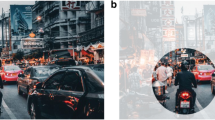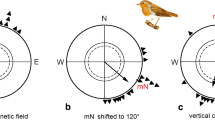Abstract
Localization of the subjective vertical during body tilt in pitch and in roll has been extensively studied because of the relevance of these axes for aviation and control of posture. Studies of yaw orientation relative to gravity are lacking. Our goal was to perform the first thorough evaluation of static orientation in recumbent yaw and to collect as efficiently as possible roll and pitch orientation data which would be consistent with the literature, using the same technique as our yaw tests. This would create the first comprehensive, coherent data set for all three axes suitable for quantitative tri-dimensional modeling of spatial orientation. We tested localization of the vertical for subjects tilted in pitch (−100° to +130°), in roll (−90° to +90°), and in yaw while recumbent (−80° to +80°). We had subjects point a gravity-neutral probe to the gravitational vertical (haptically indicated vertical) and report verbally their perceived tilt. Subjects underestimated their body tilts in recumbent yaw and pitch and overestimated their tilts in roll. The haptic settings for pitch and roll were consistent with data in the literature obtained with haptic and visual indications. Our data constitute the first tri-dimensional assessment of the subjective vertical using a common measurement procedure and provide the basis for the tri-axial modeling of vestibular function presented in the companion paper.








Similar content being viewed by others
Notes
Unlike ocular counterrolling, the doll’s eye effect is eliminated by visual fixation. The effect influences mainly the vertical axis, the eyes pitch upward when the subject is pitched forward and downward during backward tilt.
Colenbrander (1964) experimentally compared visual settings and counterrolling measurements during centrifugation and concluded that both were correlated to otolith output over a range of at least 60° of tilt (cf. also Van Beuzekom and Van Gisbergen 2000; Bohmer and Mast 1999; Bucher et al. 1992; Curthoys et al. 1990).
References
Bauermeister M, Werner H, Wapner S (1964) The effect of body tilt on tactual-kinesthetic perception of verticality. Am J Psychol 77:451–456
Benson AJ, Barnes GR (1970) Responses to rotating linear acceleration vectors considered in relation to a model of the otolith organs. In: The role of the vestibular organs in space exploration, NASA SP-314, pp 222–236
Betts GA, Curthoys IS (1998) Visually perceived vertical and visually perceived horizontal are not orthogonal. Vis Res 38:1989–1999
Bohmer A, Mast F (1999) Assessing otolith function by the subjective visual vertical. Ann NY Acad Sci 871:221–231
Bortolami SB, Rocca S, Daros S, DiZio P, Lackner JR (2006) Mechanisms of human static spatial orientation. Exp Brain Res. DOI 10.1007/s00221-006-0387-9 (current issue)
Bourdon B (1906) Influence de la force centrifuge sur la pereption de la verticale. (Influence of centrifugal force on the perception of the vertical.). Annee Psychol 12:84–94
Bucher UJ, Mast F, Bischof N (1992) An analysis of ocular counterrolling in response to body positions in three-dimensional space. J Vest Res 2:213–220
Citek K, Ebenholtz SM (1996) Vertical and horizontal eye displacement during static pitch and roll postures. J Vest Res 6:213–228
Clark B, Graybiel A (1962) Visual perception of the horizontal during prolonged exposure to radial acceleration on a centrifuge. J Exp Psychol 63:294–301
Clement G, Moore ST, Raphan T, Cohen B (2003) Perception of tilt (somatogravic illusion) in response to sustained linear acceleration during space flight. Springer, Berlin Heidelberg New York, pp 1–9
Colenbrander A (1964) Eye and otoliths. Aeromed Acta 9:45–91
Correia MJ, Hixson WC, Niven JI (1968) On predictive equations for subjective judgments of vertical and horizon in a force field. Acta Otolaryngol Suppl 230:1–20
Curthoys IS, Dai MJ, Halmagyi GM (1990) Human otolithic function before and after unilateral vestibular neurectomy. J Vest Res 1:199–209
De Beer GR (1947) How animals hold their heads. Proc Linn Soc Lond 159:125–139
DiZio P, Held R, Lackner JR, Shinn-Cunningham B, Durlach N (2001) Gravitoinertial force magnitude and direction influence head-centric auditory localization. J Neurophysiol 85:2455–2460
Glasauer S, Mittelstaedt H (1997) Perception of spatial orientation in different g-levels. J Gravit Physiol 4:5–8
Glover S (2002) Visual illusions affect planning but not control. Trends Cogn Sci 6:271–315
Goodale MA, Pelisson D, Prablanc C (1986) Large adjustments in visually guided reaching do not depend on vision of the hand or perception of target displacement. Nature 320:745–750
Howard IP, Templeton (1966) Human spatial orientation. Wiley, New York, pp 488–496
Kaptein RG, Van Gisbergen JA (2004) Interpretation of a discontinuity in the sense of verticality at large body tilt. J Neurophysiol 91:2205–2214
MacDougall R (1906) The subjective horizon. Psych Rev 4:145–166
Mast F, Jarchow T (1996) Perceived body position and the visual horizontal. Brain Res Bull 40:393–397
Mast FW, Newby NJ, Young LR (2002) Sensorimotor aspects of high-speed artificial gravity: II. The effect of head position on illusory self motion. J Vest Res 12:283–289
Miller EF, Graybiel A (1962) Counterrolling of the human eyes produced by head tilt with respect to gravity. Acta Otolaryngol 54:479–501
Miller EF, Fregly A, Graybiel A (1968) Visual horizontal perception in relation to otolith-function. Am J Psychol LXXXI:488–496
Mittelstaedt H (1983) A new solution to the problem of the subjective vertical. Naturwissenschaften 70:272–281
Mittelstaedt H (1992) Somatic versus vestibular gravity reception in man. Ann NY Acad Sci 656:124–139
Pozzo T, Berthoz A, Lefort L (1990) Head stabilization during various locomotor tasks in humans I. Normal subjects. Exp Brain Res 82:97–106
Rosenhal U (1972) Vestibular macular mapping in man. Ann Otol Rhnol Laryngol 81:339–351
Schöne H (1964) On the role of gravity in human spatial orientation. Aerosp Med 35:764–772
Van Beuzekom AD, Van Gisbergen JA (2000) Properties of the internal representation of gravity inferred from spatial-direction and body-tilt estimates. J Neurophysiol 84:11–27
Acknowledgements
This research has been supported by AFSOR grant F49620110171 and NASA grant NAG9-1483. We thank Dr. Simone Rocca and Dr. Sebastiano Daros for their contributions and experimental help.
Author information
Authors and Affiliations
Corresponding author
Rights and permissions
About this article
Cite this article
Bortolami, S.B., Pierobon, A., DiZio, P. et al. Localization of the subjective vertical during roll, pitch, and recumbent yaw body tilt. Exp Brain Res 173, 364–373 (2006). https://doi.org/10.1007/s00221-006-0385-y
Received:
Accepted:
Published:
Issue Date:
DOI: https://doi.org/10.1007/s00221-006-0385-y




